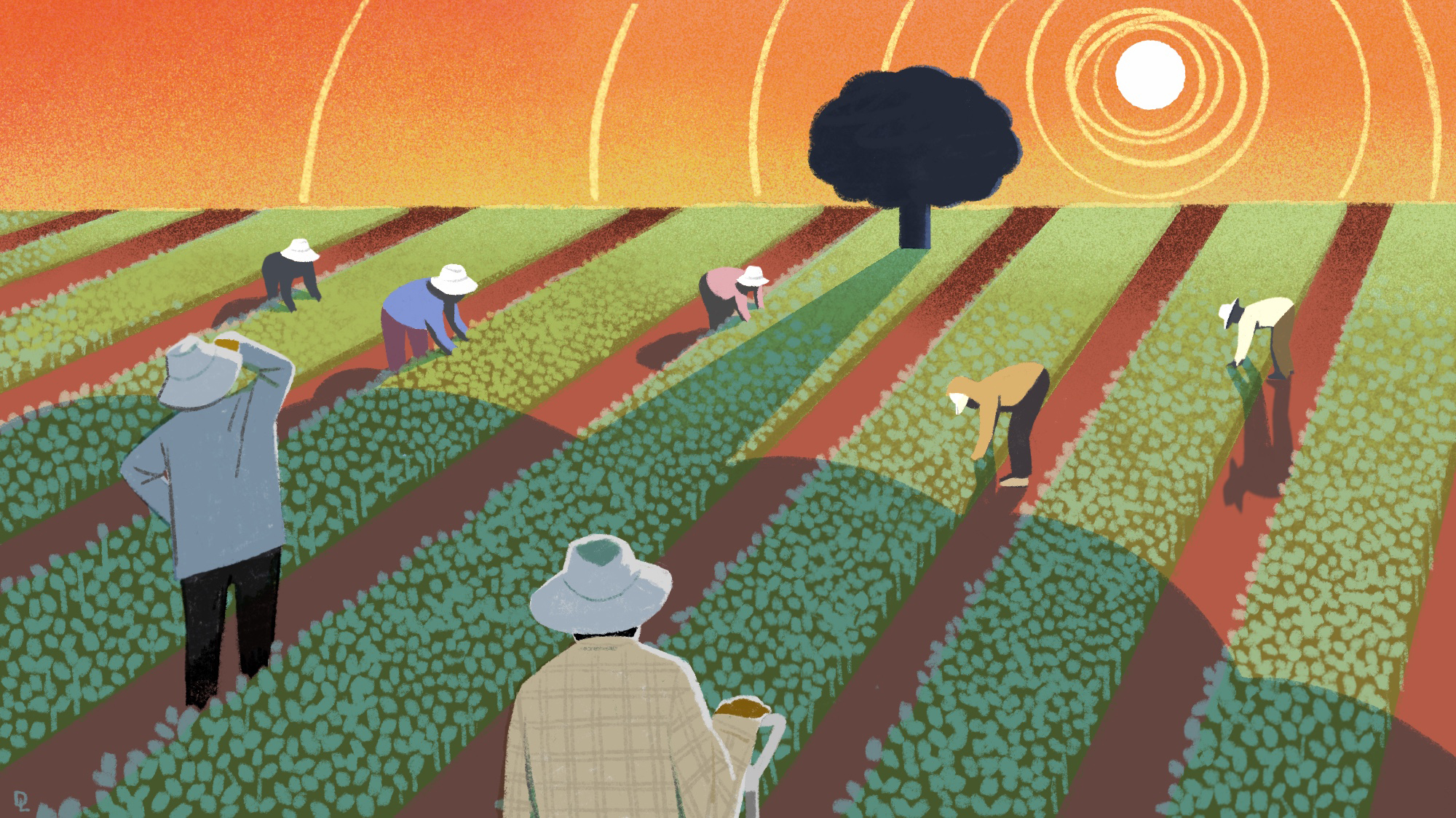The farm bill is one of the most important but least understood pieces of US legislation, and it’s overdue for renewal. But Congress couldn’t pass a new version in the fall, reflecting partisan dysfunction and also a contentious debate about what the bill ought to be—a debate that has become ensnared in the nation’s culture wars. Racial equity, food sovereignty, protections for workers, and meaningful action on climate change have broadened the bill’s traditional mandate of growing food and feeding hungry people. In this special series, a partnership with the Food and Environment Reporting Network, we’ll be exploring some of the urgent issues a new farm bill must address. Read the other stories in the series here.
Farm work has long been among the most dangerous jobs in America. But while Congress has had many chances to bolster labor protections in the 18 versions of the farm bill it has passed since 1933, it has instead largely ignored the needs of the workers who plant, tend, harvest, and process the nation’s food.
As climate change worsens, this disregard for the food system’s “essential workers” is increasingly hard to justify. Several studies have associated extreme heat with excess cardiovascular deaths. Last July, during a record-breaking heat wave in Florida, farmworker Efrain Lopez Garcia told his coworkers he was feeling sick. They found his body a few hours later near a grove of longan trees where he’d been picking fruit. That same month, Dario Mendoza collapsed and died in the fields outside Yuma, Arizona, where most of the country’s winter vegetables are grown; the heat index that day had hit 116 degrees.
Both of these men would have benefited from increased worker protections—safeguards the farm bill could provide. The legislation has long supported farm owners, through federal crop insurance and other programs; when things go wrong for farmers, the government is there to help. Yet Congress continues to treat labor as being outside the legislation’s purview. The farm bill has 12 titles, and labor is not among them. The Senate Agriculture Committee, which runs point on the bill every five years, does not include labor in the long list of issues that fall under its jurisdiction. The House Agriculture Committee launched a new labor task force last year, but its focus is ensuring a steady workforce for farmers, not expanding farmworker rights. And the US Department of Agriculture (USDA), which administers most of the farm bill’s policies, generally considers farm owners to be its constituents, not farmworkers.
The USDA has a single “Farmworker Coordinator” on staff to represent the nation’s 2 million farmworkers, and the position is not adequately resourced. A recent report by the Farm Bill Law Enterprise, a national partnership of law schools focused on the bill’s equity issues, found that the USDA rarely prioritizes research on farmworker communities. The agency often views workers as “a business input, rather than as individuals themselves,” says Emma Scott, one of the report’s lead authors and the associate director of Harvard Law School’s Food Law and Policy Clinic.
But the USDA does, in fact, administer some labor-related policies—it regulates line speeds at meatpacking plants, for instance. If necessary, the USDA could coordinate with other agencies, like the Department of Labor or the Occupational Safety and Health Administration (OSHA), on labor issues. Besides, the farm bill has a long history of expanding its scope in response to new understandings of what the bill should be. Food security initiatives like the Supplemental Nutrition Assistance Program (SNAP)—better known as food stamps—weren’t folded into the bill until the 1970s. Several of the bill’s most important conservation measures weren’t introduced until the 1980s. In other words, “The jurisdiction of the farm bill is made up,” says Sophie Ackoff, who was until recently the farm bill campaign director for the Union of Concerned Scientists. Those who argue labor is beyond the bill’s scope are “just using this as an excuse to not go there,” she says.
The focus on landowners and the exclusion of workers was baked into the first farm bill, in 1933. Plenty of New Deal legislation grappled with workers’ rights in other industries—recognizing the right to organize, for instance, and cracking down on child labor. But the Southern Democrats who dominated Congress in the 1930s wanted to preserve the region’s Jim Crow-era caste system, and they would only support Roosevelt’s labor agenda if it excluded agricultural and domestic workers, who were mostly Black.
In the decades since, a handful of states have passed laws to compensate for these oversights, such as California and Colorado. But at the federal level, farmworkers still don’t have the right to form a union or access overtime pay. Farmers also are largely exempt from child labor laws, and children as young as 12 can work unlimited hours harvesting crops provided they have their parents’ consent and don’t miss school. It’s hardly a surprise that a government audit in 2017 found that agriculture is the most dangerous work available to children in the United States; over half of all work-related child fatalities happen in agriculture, even though child farmworkers account for less than 5 percent of the country’s child workforce.
Food processing and food service workers fared better in New Deal legislation, but there are still significant gaps in worker protections in those sectors. A 2018 analysis by the Guardian of OSHA data found that the meatpacking industry suffered an average of two work-related amputations a week between 2015 and 2017. Laws that are meant to protect these workers are often unenforced, ignored by employers, or have been weakened over time. In 2020, for instance, the Trump administration authorized faster line speeds at poultry plants even though experts have repeatedly linked higher line speeds to higher injury rates. A recent report by the Government Accountability Office found that meatpacking workers were up to 70 times more likely to contract Covid-19 than the general population, and overcrowded kill floors and a general lack of safeguards were partly to blame.
Climate change is expected to make many of these hazards worse, and extreme heat poses a particular threat. A recent National Institute of Health study found that farmworkers are already 35 times more likely to die from heat than other workers, and that outdoor workers’ exposure to hazardous heat is expected to quadruple by 2065. And it isn’t just outdoor workers. In a study earlier this year, the labor advocacy group Worksafe found that more than 80 percent of California fast food workers surveyed had endured extreme heat in kitchens without air conditioning, and more than 70 percent had experienced at least one symptom of heat illness.
As Congress haggles over the 19th iteration of the farm bill, a coalition of farmworker advocacy groups, climate scientists, unions, and farmers is pushing it to incorporate basic labor protections for the first time. It’s unclear how much success they will have, but several of the policies they support have been embraced by Democrats, including Sen. Cory Booker, of New Jersey, and Rep. Greg Casar, of Texas, who sit on the Senate and House Agricultural Committees, respectively. Among the coalition’s recommendations is a warning system for dangerous weather in multiple languages that both farmers and farmworkers can access to help them prepare. Another is to replenish funding for the Farm and Food Worker Relief grant program—which was created during the pandemic—and to adequately fund emergency grants for farmworkers who lose work to wildfires, hurricanes, and floods.
Several of these programs are meant to provide farmworkers with something akin to unemployment benefits, which many farmworkers are excluded from by virtue of their immigration status.
Such proposals face long odds in the current farm bill debate. Democrats are focused on defending SNAP and Biden’s climate agenda against GOP extremists in the House, and they might not have the votes to push for more.
But coalition leaders say their work so far, including years of relationship-building among various stakeholders, has forged a solid foundation that will carry forward. Today’s coalition includes prominent progressive lobbying groups, like the National Sustainable Agriculture Coalition, which haven’t worked extensively with labor groups in the past. In July, HEAL Food Alliance, a collection of nonprofits fighting for a more equitable food system, moderated a first-ever congressional briefing on labor and the farm bill co-hosted by Booker and Alex Padilla, a California Democratic senator.
The goal, says Sophie Ackoff, is to play the long game and generate “real momentum we can use”—if not in this farm bill, then the next one. It’s a fight they can’t afford to lose.

















